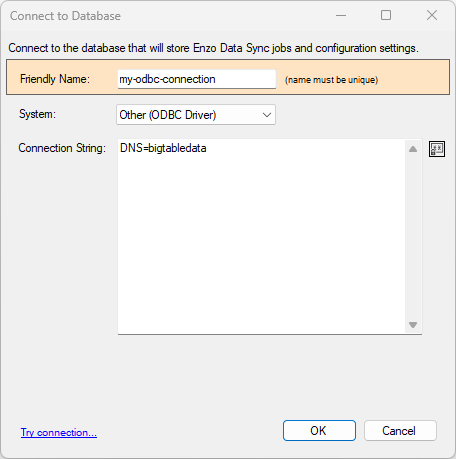Connection Strings: ODBC & OleDB
To connect to a database using another ODBC driver, or to use an OleDB connection, choose Other (ODBC Driver). To use this connection, you must have first installed the desired 64-bit ODBC driver separately or use an existing 64-bit driver on the servers where the DataZen Manager and Agent are running.

The connection string is displayed using * to hide secrets.
You can toggle the display by clicking on the password button.
When doing so, any secret included in the content of the ODBC Connection
string will be visible.
Creating a separate DNS connection is preferred, so the actual connection
string is not visible on this configuration screen. The screenshot below shows you
how to use an existing DNS name created on the local machine.
The list of ODBC drivers provided are those found on the machine where DataZen Manager is
installed. If the Sync Agent is running on another server, the Agent using the connection may,
or may not, have the same ODBC drivers available. If the selected ODBC driver is not
installed on the server where the Sync Agent is installed, the job will fail.
In addition, when using a DNS name as shown above, the same DNS name must also be created
on the Sync Agent server, if the agent is running on a separate server.
OleDB
To configure an OleDB connection, use an OleDB connection string. For example, the following connection specifies access to a local Excel file:
Provider=Microsoft.ACE.OLEDB.16.0;Data Source=C:\Tmp\test\files\netflix movie.xlsx;Extended Properties="Excel 12.0 Xml;READONLY=true;Mode=Read; HDR=YES;IMEX=1;MaxScanRows=0"
This screen displays the connection string as *** by default; to view the connection string, click on the icon to the right of the connection string. However, if a password is specified in the connection string it will become visible.

